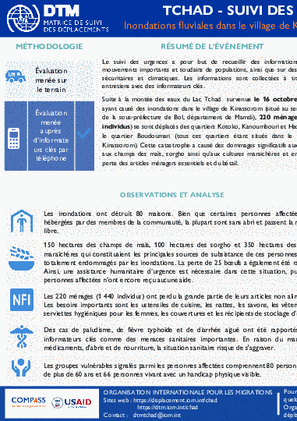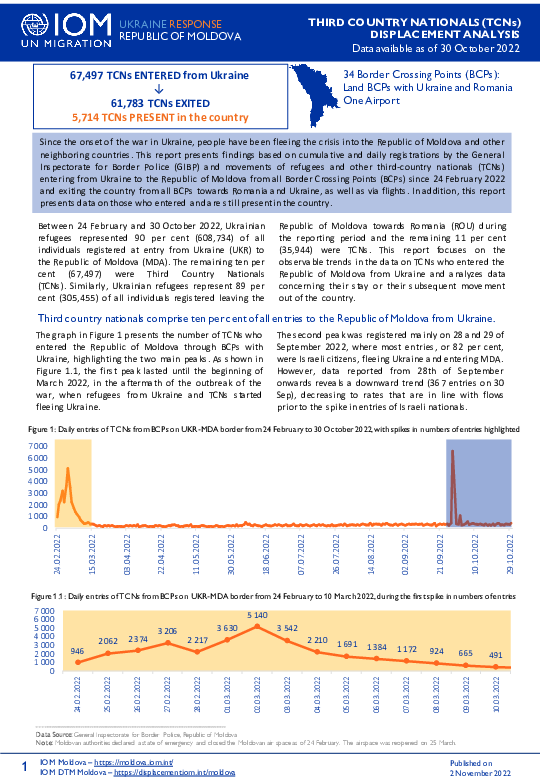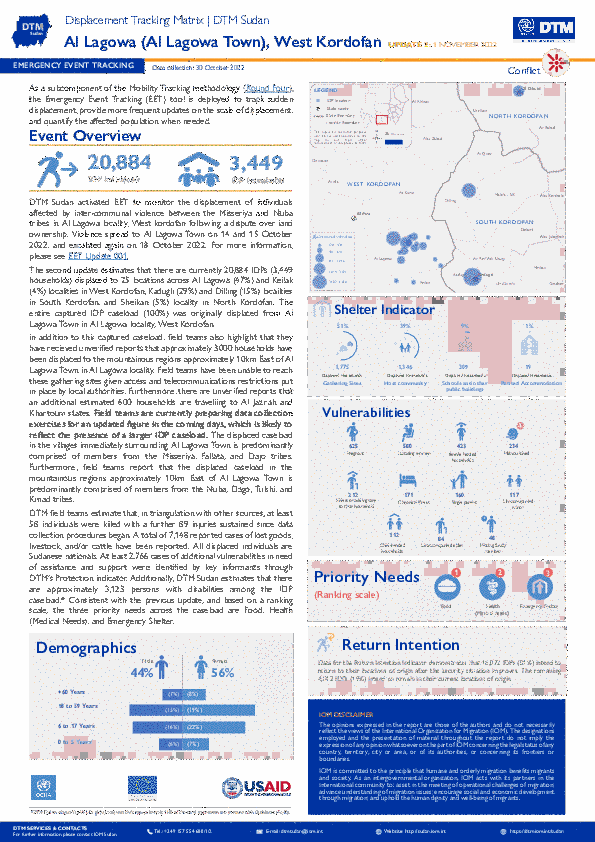-
Countries
-
Data and Analysis
-
Special Focus
-
Crisis Responses
The crisis currently affecting the Lake Chad Basin states results from a complex combination of factors, including conflict with Non-State Armed Groups, extreme poverty, underdevelopment and a changing climate, which together have triggered significant displacement of populations. As of 26 October 2022, Cameroon, Chad, Niger and Nigeria were hosting an estimated 5,876,611 affected individuals made up of Internally Displaced Persons (IDPs), Refugees (both in- and out-of-camp) and Returnees (Former IDPs and Returnees from abroad).
74 per cent of the affected population (representing 4,339,352 individuals) were located in Nigeria, while 11 per cent resided in Cameroon (658,896 individuals), 9 per cent in Chad (505,120 individuals) and 6 per cent in Niger (373,143 individuals).
La République centrafricaine (RCA) souffre d’instabilité sécuritaire, politique et économique depuis deux décennies. La dernière crise atteignant le pays a débuté en 2012, suite à une prise du pouvoir violente, et a depuis évolué en un état d’insécurité et de fragilité permanent, découlant d’une crise complexe de long-terme qui s’est étendue dans les pays voisins. La crise a conduit au décès de 506 personnes en 2022 (au 30 avril) et a déclenché des déplacements massifs de populations dans les sept pays touchés par la crise. Cette dernière est caractérisée par des rivalités pour le pouvoir parmi les élites du pays, l’absence d’institutions étatiques et d’investissement d’argent public, des tensions inter-ethniques et inter-religieuses et la lutte pour le contrôle de ressources.
Au 26 Octobre 2022, 3 555 944 individus étaient déplacés, dont 484 335 Personnes déplacées internes (14% de la population déplacée), 1 880 785 Retournés (anciennes PDI) (53%), 446 625 Retournés de l’étranger (13%) et 744 199 Réfugiés dans les pays limitrophes (21%). En RCA, les Retournés anciennes PDI représentent la plus grande population affectée (67%), tandis que les PDI représentent 17 pour cent de la population atteinte dans le pays et les Retournés de l’étranger 16 pour cent de la population déplacée présente dans le pays. Les réfugiés centrafricains résident principalement au Cameroun (351 541 individus, soit 47% des réfugiés), la République démocratique du Congo (212 120 individus, soit 29% des réfugiés) et au Tchad (124 509 individus, soit 17% des réfugiés).
The Central African Republic, which has experienced continuous volatility for the past two decades, has been riddled by a crisis which ignited in 2012 with a violent takeover of power and has developed into a complex protracted state of permanent insecurity and fragility which has spilled over into neighbouring countries. The crisis has led to the death of an estimated 506 people in 2022 (as of 30 April) and triggered significant displacement of populations in the seven affected countries. The crisis is characterized by power struggles amongst elites, the absence of state institutions and public investment, religious and ethnic tensions and disputes for the control of key resources.
As of 26 October 2022, 3,555,944 individuals were displaced, including 484,335 Internally Displaced Persons (14% of the displaced population), 1,880,785 Returnees (former IDPs) (53%), 446,625 Returnees from abroad (13%) and 744,199 Refugees in neighbouring countries (21%). In the Central African Republic, the largest displaced population consists of Former IDP Returnees (67%), while IDPs represent 17 per cent of the displaced population present in the country and Returnees from abroad represent 16 per cent of in-country displaced people. Refugees from the Central African Republic are primarily hosted by Cameroon (351,541 individuals, or 47% of refugees), the Democratic Republic of the Congo (212,120 individuals, or 29% of refugees) and Chad (124,509 individuals, or 17% of refugees).

Contact
DTM Tchad, dtmtchad@iom.int
Language
French
Location
Chad
Period Covered
Oct 21 2022
Oct 21 2022
Activity
- Mobility Tracking
- Event Tracking
Suite à la montée des eaux du Lac Tchad survenue le 16 octobre 2022 et ayant causé des inondations dans le village de Kinassorom (situé au sein des îles de la sous-préfecture de Bol, département de Mamdi), 220 ménages (1 440 individus) se sont déplacés des quartiers Kotoko, Kanoumbouri et Haoussa vers le quartier Boudoumari (tous ces quartiers étant situés dans le village de Kinassorom). Cette catastrophe a causé des dommages significatifs aux maisons, aux champs des maïs, sorgho ainsi qu’aux cultures maraichères et engendré la perte des articles ménagers essentiels et du bétail. Ces inondations ont aussi accru l’exposition des populations aux maladies zoonotiques.

Contact
DTM Chad, dtmtchad@iom.int
Language
English
Location
Chad
Period Covered
Nov 21 2022
Nov 21 2022
Activity
- Mobility Tracking
- Event Tracking
Due to rising water levels in rivers and lakes, the village of Kinassorom (located within the islands of the Bol sous-préfecture) was flooded on 16 October 2022 in the Lake province. As a result, 220 households (1,440 individuals) were displaced.

Contact
DTM Nigeria, AllUsersInDTMNigeria@iom.int
Language
English
Location
Nigeria
Period Covered
Jun 11 2022
Jun 17 2022
Activity
- Mobility Tracking
- Baseline Assessment
- Points of Entry (PoE)
During the COVID-19 pandemic, IOM's Displacement Tracking Matrix (DTM), in collaboration with the World Health Organization (WHO), monitors cross-border movements to and from Nigeria's Borno State in north-east Nigeria. Assessments are conducted at Points of Entry located along the border with Cameroon.
A range of data was collected during the assessments to better inform on travellers’ nationalities, sex, reasons for moving, mode of transportation and timeline of movement as shown in figures 2 to 5 below.

Contact
DTM Europe, DTMMediterranean@iom.int
Language
English
Location
Republic of Moldova
Period Covered
Feb 24 2022
Oct 30 2022
Activity
- Flow Monitoring
- Migrants presence
Between 24 February and 30 October 2022, Ukrainian refugees represented 90 per cent (608,734) of all individuals registered at entry from Ukraine (UKR) to the Republic of Moldova (MDA). The remaining ten per cent (67,497) were Third Country Nationals (TCNs). Similarly, Ukrainian refugees represent 89 per cent (305,455) of all individuals registered leaving the Republic of Moldova towards Romania (ROU) during the reporting period and the remaining 11 per cent (35,944) were TCNs. This report focuses on the observable trends in the data on TCNs who entered the Republic of Moldova from Ukraine and analyzes data concerning their stay or their subsequent movement out of the country.

Contact
DTM Europe, DTMMediterranean@iom.int
Language
English
Location
Republic of Moldova
Period Covered
Feb 24 2022
Oct 16 2022
Activity
- Flow Monitoring
- Migrants presence
Between 24 February and 16 October 2022, Ukrainian refugees represented 90 per cent (593,718) of all individuals registered at entry from Ukraine (UKR) to the Republic of Moldova (MDA). The remaining ten per cent (65,886) were Third Country Nationals (TCNs). Similarly, Ukrainian refugees represent 89 per cent (303,660) of all individuals registered leaving the Republic of Moldova towards Romania (ROU) during the reporting period and the remaining 11 per cent (35,893) were TCNs. This report focuses on the observable trends in the data on TCNs who entered the Republic of Moldova from Ukraine and analyzes data concerning their stay or their subsequent movement out of the country.

Contact
DTMMozambique@iom.int
Language
English
Location
Mozambique
Period Covered
Oct 29 2022
Oct 31 2022
Activity
- Mobility Tracking
- Event Tracking
Fear of attacks and confirmed attacks by Non-State Armed Groups in Namuno district (Marrumeia community) triggered 5,213 individual displacement movements from Hucula locality to Namuno sede, (Milipone locality). An estimate of 159 Internally Displaced Persons (IDPs) have been identified with vulnerabilities.
All of the recorded movements represent individuals displaced for the first time. IOM teams observed an average of 1,738 individuals arriving at different locations within the reporting period (29 -30 October, please see below for more information). Movements in the region continue to be dynamic among host communities.

Contact
DTM Sudan; dtmsudan@iom.int
Language
English
Location
Sudan
Snapshot Date
Oct 30 2022
Activity
- Mobility Tracking
- Event Tracking
The DTM Emergency Event Tracking (EET) is deployed to track sudden displacement and population movements, provide more frequent updates on the scale of displacement, and quantify the affected population when needed. As a subcomponent of the new Mobility Tracking methodology in Sudan (Round Four), and activated on a need basis, EET utilises a broad network of key informants to capture best estimates of the affected population presence per location – a useful tool for humanitarian response planning and design.



